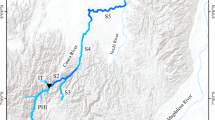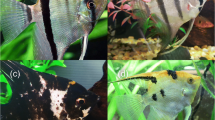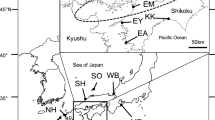Abstract
The threadsail filefish Stephanolepis cirrhifer is a highly commercial fisheries resource in Korea that suffers intensive anthropogenic pressure across much of its range. For basic information about its current genetic status in relation to stock enhancement, the level and distribution of genetic variation between a wild and a hatchery-bred population were investigated using 10 microsatellite markers developed for Thamnaconus modestus. High levels of polymorphism were observed between the two populations. A total of 95 different alleles were found at all loci, with some alleles being unique. The allelic variability ranged from six to 13 in the wild population and from five to 13 in the hatchery one. The average observed and expected heterozygosities were estimated to be 0.72 and 0.80 in the wild sample and 0.70 and 0.79 in the hatchery one, respectively. These results showed similar genetic variability in the hatchery population, as compared with the wild population and significant genetic differentiation between the wild population and the hatchery samples (F ST = 0.016, P < 0.05). Genetic drift in the intensive breeding practices for stock enhancement has probably promoted differentiation between populations. Significant deviations from Hardy-Weinberg equilibrium were detected in both populations. Our results indicate that further studies using species-specific microsatellite markers will be necessary for a more reliable assessment of genetic diversity of the species.
Similar content being viewed by others
References
Allendorf FW and Phelps SR (1980) Loss of genetic variation in a hatchery stock of cutthroat trout. Trans. Am. Fish. Soc. 109: 537–543.
An HS, Kim EM, Lee JW, Dong CM, Lee BI and Kim YC (2011a) Novel polymorphic microsatellite loci for the Korean black scraper (Thamnaconus modestus), and their application to the genetic characterization of wild and farmed populations. Int. J. Mol. Sci. 12: 4104–4119.
An HS, Kim MJ and Hong SW (2008) Genetic Diversity of Rock Bream Oplegnathus fasciatus in Southern Korea. Genes Genom.ics 30: 451–459.
An HS, Lee JW, Dong CM, Noh JK and Myeong J-I (2011b) Development and characterization of microsatellite markers for genetic analysis of the Korean black scraper, Thamnaconus modestus. Genes Genom. accepted.
Callen DF, Thompson AD, Shen Y, Phillips HA, Mulley JC and Sutherland GR (1993) Incidence and origin of “null” alleles in the (AC)n microsatellite markers. Am. J. Hum. Genet. 52: 922–927.
Chistiakov DA, Hellemans B and Volckaert FAM (2006) Microsatellites and their genomic distribution, evolution, function and applications: A review with special reference to fish genetics. Aquaculture 255:1–29.
DeWoody JA and Avise JC (2000) Microsatellite variation in marine, freshwater and anadromous fishes compared with other animals. J. Fish. Biol. 56: 461–473.
Elliott NG and Reilly A (2003) Likelihood of a bottleneck even in the history of the Australian population of Atlantic salmon (Salmo salar L.). Aquaculture 215: 31–44.
Excoffier L, Laval G and Schneider S (2005) ARLEQUIN ver 3.0: an integrated software package for population genetics data analysis. Evolutionary Bioinformatics Online 1, 47–50.
Excoffier L, Smouse PE and Quattro JM (1992) Analysis of molecular variance inferred from metric distances among DNA haplotypes: application to human mitochondrial DNA restriction data. Genetics 131:479–491.
Feral JP (2002) How useful are the genetic markers in attempts to understand and manage marine biodiversity?. J. Exp. Mar. Biol. Ecol. 268:121–145.
Fitzsimmons NN, Moritz C and Moore SS (1995) Conservation and dynamics of microsatellite loci over 300 million years of marine turtle evolution. Mol. Biol. Evol. 12: 432–440.
Kim M-J, An HS and Choi KH (2010) Genetic characteristics of Pacific cod populations in Korea based on microsatellite markers. Fishe. Sci. 76:595–603.
Kim PD (2007) Scuba Diver. In Miniature guide to whole Korean fishes, P.D. Kim, eds., Poong Deung Press, Seoul, pp. 215.
Li Q, Park C, Endo T and Kijima A (2004) Loss of genetic variation at microsatellite loci in hatchery strains of the Pacific abalone (Haliotis discus hannai). Aquaculture 235: 207–222.
Liu N, Chen L, Wang S, Oh S, and Zhao H (2005) Comparison of single-nucleotide polymorphisms and microsatellites in inference of population structure. BMC Genetics. 30:6 Suppl 1, S26.
Liu ZJ and Cordes FJ (2004) DNA marker technology and their applications in aquaculture genetics. Aquaculture 238:1–37.
Marchant S, Haye PA, Marín SA and Winkler FM (2008) Genetic variability revealed with microsatellite markers in an introduced population of the abalone Haliotis discus hannai Ino. Aquacul. Res. 40: 298–304.
MIFAFF-Ministry for Food, Agriculture, Forestry and Fisheries of Korea (2009) Annual Statistics of Fisheries Production in 1990–2009. Ministry for Food, Agriculture, Forestry and Fisheries, Seoul (In Korean).
Miyajima Y, Masuda R, Kurihara A, Kamata R, Yamashita Y and Takeuchi T (2011) Juveniles of threadsail filefish, Stephanolepis cirrhifer, can survive and grow by feeding on moon jellyfish Aurelia aurita. Fishe. Sci. 77: 41–48.
Primmer CR, Aho T, Piironen J, Estoup A, Cornuet JM and Ranta E (1999) Microsatellite analysis of hatchery stocks and natural populations of Arctic charr, Salvelinus alpinus, from the Nordic region: implications for conservation. Hereditas 130: 277–289.
Porta J, Porta JM, Martínez-Rodríguez G and Alvarez MC (2006) Genetic structure and genetic relatedness of a hatchery stock of Senegal sole (Solea senegalensis) inferred by microsatellites. Aquaculture 251: 46–55.
Reiss H, Hoarau G, Dickey-Collas M and Wolff WJ (2009) Genetic population structure of marine fish: mismatch between biological and fisheries management units. Fish Fisher. 10: 361–395.
Rice WR (1989) Analyzing tables of statistical tests. Evolution 43: 223–225.
Rico C, Rico I and Hewitt G (1996) 470 million years of conservation of microsatellite loci among fish species. Proc. R. Soc. Lond. B Biol. Sci. 263: 549–557.
Schlötterer C, Amos B and Tautz D (1991) Conservation of polymorphic simple sequence loci in cetacean species. Nature 354: 63–65.
Slatkin M and Excoffier L (1996) Testing for linkage disequilibrium in genotypic data using the EM algorithm. Heredity 76: 377–383.
van Oosterhout C, Hutchinson WF, Wills DPM and Shipley P (2004) MICRO-CHECKER: software for identifying and correcting genotyping errors in microsatellite data. Mol. Ecol. Notes 4: 535–538.
Wahlund S (1928) Zusammensetzung von Populationen und Korrelationserscheinungen vom Standpunkt der Vererbungslehre aus betrachtet. Hereditas 11: 65–106.
Weir BS and Cockerham CC (1984) Estimating F-Statistics for the analysis of population structure. Evolution 38: 1358–1370.
Zhan A, Hu J, Hu X, Zhou Z, Hui M, Wang S, Peng W, Wang M and Bao Z (2009) Fine-scale population genetic structure of Zhikong scallop (Chlamys farreri): do local marine currents drive geographical differentiation?. Mar. Biotecnol. 11: 223–235.
Author information
Authors and Affiliations
Corresponding author
Rights and permissions
About this article
Cite this article
An, H.S., Hong, S.W., Kim, E.M. et al. Comparative genetic diversity of wild and hachery populations of Korean threadsail filefish Stephanolepis cirrhifer using cross-species microsatellite markers. Genes Genom 33, 605–611 (2011). https://doi.org/10.1007/s13258-011-0109-y
Received:
Accepted:
Published:
Issue Date:
DOI: https://doi.org/10.1007/s13258-011-0109-y




